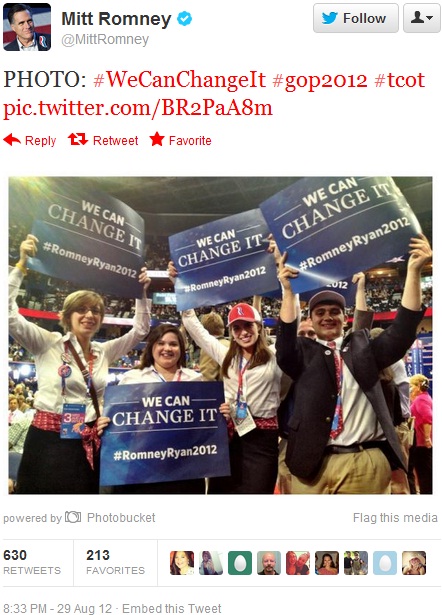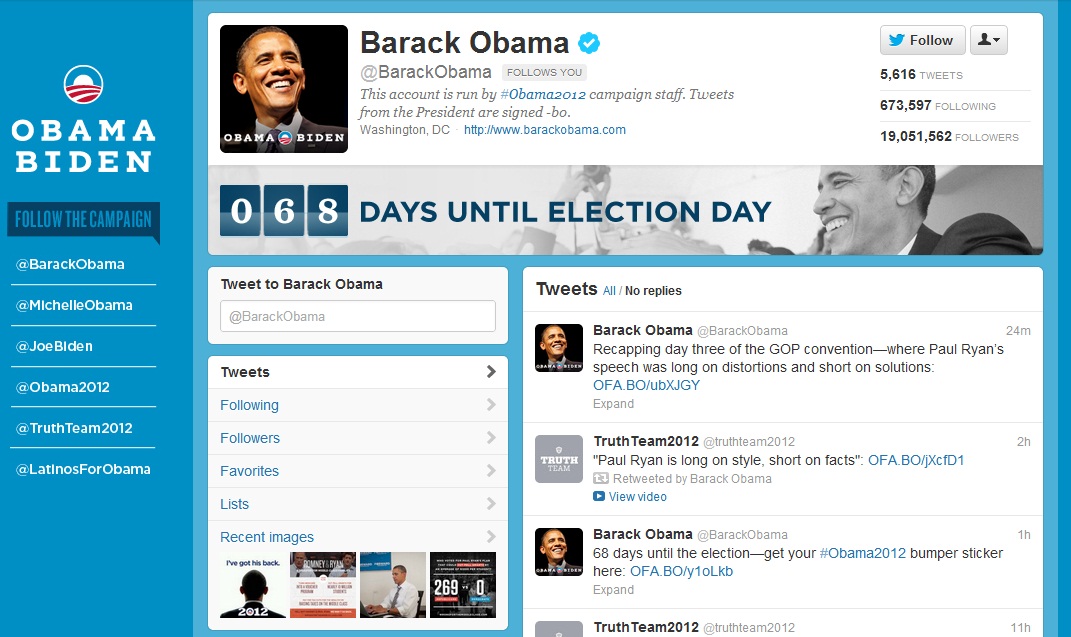Oxford University Press USA is putting together a series of articles on a political topic each week for four weeks as the United States discusses the upcoming American presidential election, and Republican and Democratic National Conventions. Our scholars previously tackled the issues of money and politics, and the role of political conventions. This week we turn to the role of media in politics.
By Daniel Kreiss
A recent Pew study on the presidential candidates’ use of social media described Barack Obama as having a “substantial lead” over Mitt Romney. The metrics for the study were the amounts of content these candidates post, the number of platforms the campaigns are active on, and the differential responses of the public.
Metrics such as these often tell us very little about how campaigns are actually using social media and the Internet more generally, and their relative strategies for and success in doing so. If there is anything that I found in my last six years of researching new media and electoral campaigns, it is that much of what makes for the successful uptake of new media is often the organizational decisions that receive scant scholarly and journalistic attention. A focus on platforms and content tells us little about the issues of campaign organization, staffing, and coordination of digital and field efforts around electoral strategy that have much more impact on electoral success.

A screencap of twitter.com/MittRomney/status/240970452950994944 on 30 August 2012.
This organizational role, in turn, helps integrate new media operations within the larger electoral strategy of the campaign. This is important because effective campaigns take up new media in accordance with their electoral goals, and investments in new media have to be evaluated in light of overall campaign strategy. There are very real differences between the presidential candidates, their parties, their supporter and donor bases, and electoral strategies — so much so that we should not expect them to have the same goals for, strategies of using, and investments in their use of new and social media.
During the 2008 cycle, for example, the Obama team took to new media early on, with the specific goal of using an array of tools to overcome the institutional advantages of Senator Hillary Clinton. For the campaign, this meant using new media as a fundraising and especially organizing tool in accordance with the larger electoral goal of expanding the electorate among groups favorable to Obama with historically low rates of turnout: youth and African Americans. Above all, it meant using new media to translate the incredible energy of supporters gathering around the candidate into resources that campaigns need: money, message, volunteers, and ultimately, votes. And yet, while this worked for Obama, other candidates with essentially the same tools could not inspire the same supporter mobilization. The story of the 2008 Obama campaign is neatly summed up in what Michael Slaby, the 2008 campaign’s chief technology officer and the 2012 campaign’s chief integration and innovation officer, said to me: “We didn’t have to generate desire very often. We had to capture and empower interest and desire…. We made intelligent decisions that kept it growing but I don’t think anybody can really claim we started something.”

A screencap of twitter.com/BarackObama on 30 August 2012.
In this light, the continual hope, exemplified in the Pew Study, for “transforming campaigning into something more dynamic, more of a dialogue,” and the inevitable let down when this does not occur, is a case of our democratic aspirations placing undo expectations on campaigns. Campaigns have very concrete metrics for success given electoral institutions. Campaigns are temporal entities with defined goals: garnering the resources and ultimately the votes necessary to win elections. They are not about democratic renewal, although certainly that can happen. Furthermore, much of the discourse calling for dialogue ignores a fundamental fact: the goals of campaigns and their supporters on social media are often closely aligned around defeating opponents. Supporters embrace tasks and respond to one-way messaging because their goal is to win on election day, not remake democratic processes.
Indeed, a close look at the networked tools campaigns across the aisle are now routinely using in 2012 reveals an emphasis on electoral gain, and integrating tools within larger electoral strategy. The story of the last decade in electoral campaigning has been both about a reinvestment in old fashioned, shoe leather campaigning coupled with new data infrastructures designed to more efficiently and effectively coordinate volunteers and leverage their time, efforts, and social networks. As Rasmus Nielsen has analyzed in his recent book, in the face of widespread practitioner recognition of the diminishing returns of broadcast television ads, fragmented audiences, narrowly decided contests, and social science findings, campaigns have increasingly enlisted humans as media through what he calls “personalized political communication.” Campaigns deploy field volunteers on the basis of voter modeling and targeting supported by a vast, national data infrastructure stitched together from a host of public (voter registration, turnout, and real estate records), commercial (credit card information, magazine subscription lists), party (historical canvass data), and increasingly social network data.

A mobile phone screen cap of facebook.com/mittromney on 30 August 2012.
Alongside the fashioning of supporters into media and their social networks into channels, campaigns have developed sophisticated “computational management” practices that leverage media as internal and external coordination devices. New media is a closed loop; every expenditure can be tracked in terms of its return on investment given the ability to generate real time results of supporters’ interactions with networked media. If creating digital two step flows remains more art than science as campaigns struggle to make content go viral, optimizing web content and online advertising is data-driven to probabilistically increase the likelihood that supporters will take the actions campaigns want them to. Optimization is based around continually running experimental trials of web content and design in order to probabilistically increase the likelihood of desired outcomes. This means campaigns vary the format, colors, content, shapes, images, and videos of a whole range of email and website content based on the characteristics of particular users to find what is most optimal for increasing returns. In 2008, for example, the Obama campaign created over 2,000 different versions of its contribution page, and across the campaign optimization accounted for $57 million dollars, which essentially paid for the campaign’s general election budgets in Florida and Ohio.
At the same time, while television advertising has dominated campaign expenditures for much of the last half century, campaigns are increasingly investing in online advertising, which is premised on being able to access new sources of behavioral, demographic, and affinity data that allows for the more sophisticated targeting and tailoring of political messages. Campaigns can match online IP addresses with party voter files, allowing them to target priority voters. Campaigns use this matching, along with behavioral, demographic, interest, and look-alike targeting (matching voters based on the characteristics they share with others with known political preferences), to deliver online ads for the purposes of list-building, mobilizing supporters to get involved, and persuading undecideds.
Despite the best attempts of staffers, campaigns remain messy, complicated affairs. While it would be easy to see things such as computational management and online advertising in Orwellian terms, the reality is that campaigns are continually creating and appropriating new tools and platforms because their control over the electorate is limited. Candidates still contend with intermediaries in the press, opponents engaging in their own strategic communications, and voters who have limited attention spans, social attachments, and partisan affiliations that mitigate the effects of even the most finely tailored advertising. Millions, meanwhile, refuse to engage in the process, a massive silent minority that campaigns only spend significant resources on if they have them. There must always be political desire that exists prior to any of these targeted communications practices, or else supporters and voters will tune them out like much else that is peripheral to their core concerns.
In the end, as another presidential general election takes shape, we see continuities in electoral politics in the face of considerable technological change.
Daniel Kreiss is Assistant Professor in the School of Journalism and Mass Communication at the University of North Carolina at Chapel Hill. Kreiss’s research explores the impact of technological change on the public sphere and political practice. In Taking Our Country Back: The Crafting of Networked Politics from Howard Dean to Barack Obama (Oxford University Press, 2012), Kreiss presents the history of new media and Democratic Party political campaigning over the last decade. Kreiss is an affiliated fellow of the Information Society Project at Yale Law School and received a Ph.D. in Communication from Stanford University. Kreiss’s work has appeared in New Media and Society, Critical Studies in Media Communication, The Journal of Information Technology and Politics, and The International Journal of Communication, in addition to other academic journals. You can find out more about Kreiss’s research at http://danielkreiss.com or follow him on Twitter at @kreissdaniel
Subscribe to the OUPblog via email or RSS.
Subscribe to only law and politics articles on the OUPblog via email or RSS.
View more about this book on the ![]()
![]()


